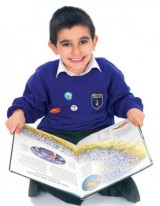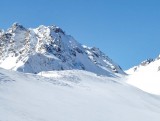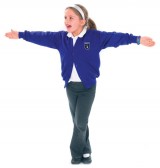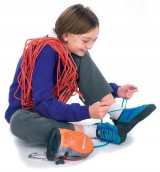Peter Greaves looks at how to make sure your next topic on mountains reaches new heights...
You never know what talents staff and parents may be hiding…
Pupils are more likely to remember words, experiences and stories told by guests and visitors, as opposed to reading about them or watching videos. There is something inspirational about linking learning to the real world and this is best done through meeting people. Topics such as ‘Mountains’ bring the most unlikely resources out of people; there are lots of potential visitors out there just waiting to be asked. If you start spreading the word that you are looking at mountains, you will find that within the staffroom are people who bring something special to lessons either directly or through contacts. In our school, after a bit of asking around, we found:
• A local headteacher who had climbed Mt. Kilimanjaro and was happy to come in and share her story
• A parent who had a friend who had climbed Everest
• Some members of a local climbing group who could lend ropes and equipment
• A staff member who had tracked Mountain Gorillas in Uganda
• Lots of skiers who could lend us jackets, overtrousers and other equipment
• A family with relatives in Switzerland who could talk about living in the mountains
This is not just good luck. If our schools are making the curriculum relevant to the world in which pupils are growing up, then there will be lots of natural connections within our extended school communities and all of them enliven classroom learning. This was the case in our WW2 topic where we held an evacuees tea for residents of a retirement home who came in to talk to us about their experiences. In our work on space, a parent showed us how to arrange a loan of genuine moon rock. A parent even had a contact in a local Viking reenactment society, who came in to do battle in our playground. It seems to be the case that if you ask, you often get.
 A captivating story can provide topical fodder for fiction…
A captivating story can provide topical fodder for fiction…
One of the best assets of an extended topic is that it allows a book to be read in its entirety. If the non-fiction elements of a unit demand careful selection of relevant extracts, it is really important to balance this with the reading of whole texts whenever possible. Of course the book should be linked to the topic, but it is much more important that the book is good than a perfect fit. I would recommend a story with an epic journey in it, such as Michael Morpurgo’s Kensuke’s Kingdom or for younger children, Robert Swindell’s The Ice Palace. You could then:
• Draw a map of the journey undertaken by one of the characters
• Write diary entries at key points
• Write letters from those undertaking the journey to those who are left behind
• Draw ‘double bubble maps’ contrasting different settings
• Role-play different sections of the story to highlight particular difficulties presented by tough terrain
• Choose a passage that contains particularly descriptive language. Use Talk for Writing techniques to produce a story map for the passage and then orally retell it.
 Sir Edmund Hillary can be the touchstone for your topic…
Sir Edmund Hillary can be the touchstone for your topic…
If people are not able to visit in person, topics can be made more tangible by studying inspiring figures relevant to the subject. Just as a key image can help to lock information in a pupil’s memory, a key person can help pupils to make links between the various aspects of a topic. In most topics, there is a particular character who encapsulates the spirit of the theme and this person can then provide a reference point for what has been learnt in the wider sense.
Sir Edmund Hillary is a perfect example of how an inspirational figure can be that touchstone. There is a lot of material available on his life story and experiences before, during and after his famous ascent of Everest in 1953. Websites such as: http://teacher.scholastic.com/activities/hillary/ provide enough detail to be helpful for teachers, yet are also simple enough or pupils to access and make use of. There are also many video resources available; both contemporary that show how the event was covered at the time and reflective that show the impact of the climb on both Hillary and the wider world.
An added dimension is brought to Hillary’s story by his friendship with Tenzing Norgay. Details such as Hillary’s refusal to say who reached the top first generates much discussion with older children and can allow exploration of many SEAL or PSHE topics.
 Investigate song lyrics…
Investigate song lyrics…
There are many mountain poems available, but if you find it hard to motivate older pupils with poetry, try looking at song lyrics. Mountains figure prominently in songs, with the lyrics being only a Google away. By looking at a range of songs from different decades and genres, it becomes possible to identify and highlight themes. Looking at mountains, for example, you see that they are frequently portrayed as either an obstacle to achieving a dream or as something grand and majestic. The lyrics offer a wide variety of phrases and metaphors that can be drawn out to provide a wordbank for pupils to use in creative writing. If you want a few songs to get started, try:
River deep, mountain high Tina Turner Climb Every Mountain The Sound of Music Ain’t no Mountain High Enough Marvin Gaye and Tammi Terrell (This is also available on the Sing Up website – singup.org – and would make a great theme song for the class to learn) The World’s Greatest R.Kelly ...but I bet you can think of loads more.
 Developing a range of cold weather clothing opens the door to persuasive writing skills…
Developing a range of cold weather clothing opens the door to persuasive writing skills…
Designing products opens the door not just to art and design work, but also to many different writing opportunities. Generating an original product gives pupils a vested interest in the subsequent work, which all helps to extend the life of a topic. For example, pupils really enjoy the chance to design mountain clothing. A quick internet search will turn up videos such as this one for a mountain jacket: livefortheoutdoors.com/News-Landing/Search-Results/Gearnews/GEAR-VIDEO-Quito
Once children get the idea, then you mountains can take the class through the design/evaluation process at whatever pace is appropriate, stopping to emphasise whichever aspect best addresses any learning objectives. Comparing different jackets will bring out the key requirements of this item of clothing and a wordbank of technical vocabulary can be generated for pupils to use in their own writing.
One fruitful direction for this work is to focus on persuasive writing. Can pupils write a leaflet to launch their jacket or write a radio advert that would target the correct audience for their design? A class swap could beorganised, so that pupils have to pitch their jacket to a different staff member in a Dragon’s Den style. If you have made contacts with climbers as suggested earlier, they could be asked to comment on the designs and feedback to pupils which appeal was the most persuasive.
A practical approach to teaching contour lines…
Google Earth is one of those teaching tools that allows you to do something that was not possible even a few years ago. As you study and look at mountains, you can actually visit them! Link map work to this ICT resource by allowing pupils to locate particular mountain ranges in their atlases. They can then ‘fly in’ from their own location to see how they look. The imaging of the main ranges of the world is very good. Children can zoom in and out to get a sense of perspective, and using the tilting tool allows them to get a real sense of the scale of those towering peaks.
To follow this up, get hold of some plasticine and ask pupils to make their own mountains. They could try to copy the shapes of the different mountains they have seen, be they fold mountains, dome mountains, volcanoes or any of the other major mountains. Show pupils how to slice their mountains into layers of about 1 cm thick. By drawing round these, starting from the base to form a concentric pattern, pupils will produce contour lines. Show them how these relate to the contour lines on real maps and see if they can begin to identify the tallest hills and peaks in their own locality, and how the steepness of hills can be represented on a flat piece of paper.
1. Non-fiction work could focus on researching to write a nonchronological report. Established topics such as this are normally well resourced in schools with both textbooks and video material. These can be supplemented by carefully selected websites such as: woodlands-junior.kent.sch.uk/homework/mountains
2. Organise the class into groups and ask them to research the different mountain ranges.
• Where is the mountain range?
• What is the tallest peak?
• What is the weather like?
• Who lives on the mountain ranges?
Kindness is contagious - give your colleagues a boost by recognising their efforts
Ace-Classroom-Support
Make World Book Day Extra Special This Year
Ace-English
